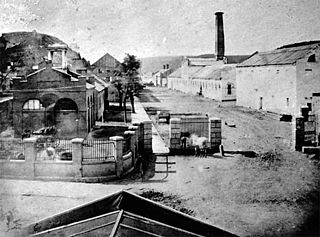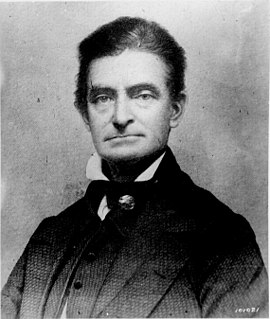
Harpers Ferry, population 286 at the 2010 census, is a historic town in Jefferson County, West Virginia, United States, in the lower Shenandoah Valley. It is situated at the confluence of the Potomac and Shenandoah rivers, where the U.S. states of Maryland, Virginia, and West Virginia meet. It is the easternmost town in West Virginia and during the Civil War the northernmost point of Confederate-controlled territory. The town's original, lower section is on a flood plain created by the two rivers and surrounded by higher ground.

John Brown was an American abolitionist. Brown advocated the use of armed insurrection to overthrow the institution of slavery in the United States. He first gained national attention when he led small groups of volunteers during the Bleeding Kansas crisis of 1856. He was dissatisfied with the pacifism of the organized abolitionist movement: "These men are all talk. What we need is action—action!" In May 1856, Brown and his supporters killed five supporters of slavery in the Pottawatomie massacre, a response to the sacking of Lawrence by pro-slavery forces. Brown then commanded anti-slavery forces at the Battle of Black Jack and the Battle of Osawatomie.

Jefferson County is located in the Shenandoah Valley and is the easternmost county of the U.S. state of West Virginia. As of the 2010 census the population was 53,498. Its county seat is Charles Town. The county was founded in 1801, and today is part of the Washington metropolitan area.

A Plea for Captain John Brown is an essay by Henry David Thoreau. It is based on a speech Thoreau first delivered to an audience at Concord, Massachusetts, on October 30, 1859, two weeks after John Brown's raid on Harpers Ferry, and repeated several times before Brown's execution on December 2, 1859. It was later published as a part of Echoes of Harper's Ferry in 1860.

The Boston Navy Yard, originally called the Charlestown Navy Yard and later Boston Naval Shipyard, was one of the oldest shipbuilding facilities in the United States Navy. It was established in 1801 as part of the recent establishment of the new U.S. Department of the Navy in 1798. After 175 years of military service, it was decommissioned as a naval installation on 1 July 1974.

A dock landing ship is an amphibious warfare ship with a well dock to transport and launch landing craft and amphibious vehicles. Some ships with well decks, such as the Soviet Ivan Rogov class, also have bow doors to enable them to deliver vehicles directly onto a beach. Modern dock landing ships also operate helicopters.

USS Harpers Ferry (LSD-49) is the lead ship of her class of landing ship dock of the United States Navy. This warship was named for the town of Harpers Ferry, West Virginia, which, because of the U.S. arsenal there, was an important location during the Civil War. USS Harpers Ferry is assigned to the Navy's "Amphibious Group 1". The homeport of Harpers Ferry is at San Diego County, California. Harpers Ferry was previously stationed at the American Naval Base in Sasebo, Nagasaki, Japan before she was relieved in 2011 by USS Germantown.

USS Carter Hall (LSD-50) is a Harpers Ferry-class dock landing ship of the United States Navy. She is the second U.S. Navy ship to be named for Carter Hall, an estate near Winchester, Virginia, built in the 1790s.

Harpers Ferry National Historical Park is located at the confluence of the Potomac and Shenandoah rivers in and around Harpers Ferry, West Virginia. The park includes land in the Shenandoah Valley in Jefferson County, West Virginia; Washington County, Maryland and Loudoun County, Virginia. The park is managed by the National Park Service, an agency of the U.S. Department of the Interior. Originally designated Harpers Ferry National Monument in 1944, the park was declared a National Historical Park by the U.S. Congress in 1963. The park includes the historic town of Harpers Ferry, notable as a center of 19th-century industry and as the scene of John Brown's failed abolitionist uprising. Consisting of almost 4,000 acres (16 km2), it includes the site of which Thomas Jefferson once wrote, "The passage of the Potomac through the Blue Ridge is perhaps one of the most stupendous scenes in Nature" after visiting the area in 1783. Due to a mixture of historical events and ample recreational opportunities, all within 50 miles (80 km) of Washington, D.C., the park was listed on the National Register of Historic Places on October 15, 1966. The Park's Superintendent is presently Tyrone Brandyburg.

John Brown's Fort was originally constructed in 1848 for use as a guard and fire engine house by the federal Harpers Ferry Armory in Harpers Ferry, West Virginia, then a part of Virginia.

Virginia v. John Brown was a criminal trial held in Charles Town, Virginia, in October of 1859. The abolitionist John Brown was prosecuted for his involvement in a raid on the United States federal arsenal at Harpers Ferry, Virginia. On October 16–18, 1859, Brown led 21 armed men, 5 Black and 16 white, to Harpers Ferry, an important railroad junction. His goal was to seize the federal arsenal there and then lead a slave insurrection across the South. Brown and his men engaged in a two-day standoff with local militia and federal troops, in which ten of his men were shot or killed, five were captured, and five escaped. Brown was captured and put on trial in a Virginia state court for treason, murder, and fomenting a slave insurrection. He was found guilty on all counts, and hanged on December 2.

The Harpers Ferry class of the United States Navy is a class of dock landing ships completed in the early 1990s. Modified from the Whidbey Island class, the design sacrifices landing craft capacity for more cargo space, making it closer to an amphibious transport dock type, but was not designated as such. Externally, the two classes can be distinguished by the positions of weapons: The Harpers Ferry class has the Phalanx CIWS mounted forward, and the RAM launcher on top of the bridge, while the Whidbey Island has the opposite arrangement.
Two ships of the United States Navy have borne the name USS Oak Hill, in honor of Oak Hill plantation, the estate of James Monroe, the fifth U.S. President, in Loudoun County, Virginia.

Harpers Ferry Armory, more formally known as the United States Armory and Arsenal at Harpers Ferry, was the second federal armory commissioned by the United States government. It was located in Harpers Ferry, West Virginia, while the first federal armory was the Springfield Armory located in Springfield, Massachusetts. In many books, the town is called "Harper's Ferry" with an apostrophe.
James H. Burton was born in Shenandoah Spring, Virginia. Educated at the Westchester Academy in Pennsylvania, Burton entered a Baltimore machine shop at age 16. In April 1844, he went to work at the Harpers Ferry Armory, serving as a machinist. He subsequently served as Foreman of the Rifle Factory Machine Shop, where he gained a considerable amount of knowledge and respect for the work of John H. Hall. Hall pioneered mechanized arms production and interchangeable manufacture at Harpers Ferry between 1820-1840. According to Burton, Hall's Rifle Works housed "not an occasional machine, but a plant of milling machinery by which the system and economy of the manufacture was materially altered." During the next three decades, Burton followed Hall's example by furthering the mechanization of arms production.

The Kennedy Farm is a National Historic Landmark property on Chestnut Grove Road in rural southern Washington County, Maryland. It is notable as the place where the radical abolitionist John Brown planned and began his raid on Harpers Ferry, West Virginia in 1859. Also known as John Brown's Headquarters and Kennedy Farmhouse, the log, stone and brick building has been restored to its appearance at the time of the raid. The farm is now owned by a preservation nonprofit.

John Brown's raid on Harpers Ferry was an effort by abolitionist John Brown, from October 16 to 18, 1859, to initiate a slave revolt in Southern states by taking over a United States arsenal at Harpers Ferry, Virginia. It has been called the dress rehearsal for the Civil War.
Alfred Madison Barbour was a Virginia lawyer, one-term delegate in the Virginia House of Delegates and also in the Virginia Secession Convention of 1861. He may be best known for his role as Superintendent of the Harpers Ferry Armory in Harpers Ferry, Virginia during John Brown's raid. Although Barbour voted against secession, he became a major in the Confederate States Army and served as a quartermaster during the American Civil War.
Events from the year 1859 in the United States.
The Heyward Shepherd monument, in Harpers Ferry, West Virginia, was erected in 1931, after decades of controversy, by the United Daughters of the Confederacy (UDC) and to a lesser extent by the Sons of Confederate Veterans. It commemorates Heyward Shepherd, a free black man, who was the first person killed during John Brown's raid on Harpers Ferry. The monument was intended to document the Lost Cause allegation that there were happy, unrebelious slaves. There is no evidence that Shepherd was born a slave; there is also no evidence that he was opposed to John Brown's attempt to end American slavery, or that he had even heard of it. Nevertheless, it was intended to be a reply to blacks' glorification of Brown, in whose honor Storer College had been established in Harpers Ferry; the College placed a plaque on the Armory in 1918. There was no better place, from the UDC's point of view, for a monument to the "happy slave" than Harpers Ferry.












